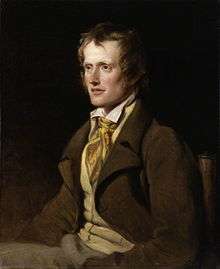William Hilton
.jpg)

William Hilton RA (3 June 1786 – 30 December 1839), was an English portrait and history painter.
Life and work
Hilton was born in Lincoln, the son of a portrait-painter; he may be known as "William Hilton the Younger". Although he is best known today for simple portraits of the poets John Keats and John Clare, he was successful in his lifetime with huge history paintings in the "Grand Manner", which have not benefited from the revival of interest in 19th-century British Academic art, and unlikely to be on display in the museums that own them.
In 1800, Hilton was apprenticed to the engraver John Raphael Smith, and around the same time enrolled at the Royal Academy school. Hilton first exhibited there in 1803, sending a Group of Banditti and soon established a reputation for choice of subject, and qualities of design and colour superior to the great mass of his contemporaries. He made a tour in Italy with Thomas Phillips, the portraitist.
In 1813, having exhibited "Miranda and Ferdinand with the Logs of Wood," he was elected as an associate of the Academy, and in 1820 as a full academician; his diploma-picture representing Ganymede. In 1823, he produced "Christ crowned with Thorns," a large and important work regarded as his masterpiece, subsequently bought as the first purchase of the Chantrey Fund in 1878. In 1827 he succeeded Henry Thomson as Keeper of the Royal Academy.[1] Two of his works were bought by the British Institution for churches for £525 and £1050, but the failure of "Edith finding the Body of Harold" (1834) to make more than £200 marked the end of the taste for such works. Hilton may be compared with Benjamin Haydon, though he was always more successful.[2] He died in London on 30 December 1839.
Some of his strongest pictures include "Angel releasing Peter from Prison" (life-size), painted in 1831, "Una with the Lion entering Corceca's Cave" (1832), the "Murder of the Innocents," his last exhibited work (1838), "Comus" and "Amphitrite". The Tate Gallery now owns "Edith finding the Body of Harold" (1834), "Cupid Disarmed, Rebecca and Abraham's Servant" (1829), "Nature blowing Bubbles for her Children" (1821), and "Sir Calepine rescuing Serena" (from The Faerie Queene) (1831).[3] In the National Portrait Gallery is his likeness of John Keats, with whom he was acquainted.
Notable works
- Murder of the Innocents, his last exhibited work, 1838.
- Edith finding the Body of Harold, 1834.
- Venus in Search of Cupid Surprises Diana (Before 1820), Wallace Collection, London.
- Hebe
- Rape of Ganumede, 1806, Royal Academy of Art Collection, London
- Cupid and the Nymphs, 1830, Royal Academy of Art Collection, London
- Rape of Proserpine
- Una and Satyrs, Lincolnshire County Council art collection.
- Phaeton, c 1820, Manchester Art Gallery.
- John Clare, portrait, 1820, National Portrait Gallery, London
- John Keats, portrait, c1822, National Portrait Gallery, London
- Diana at the Bath circa 1820, Tate Gallery, London
- Nature Blowing Bubbles for her Children exhibited 1821, Tate Gallery, London
- Cupid and Nymph exhibited 1828, Tate Gallery, London
- Sir Calepine Rescuing Serena exhibited 1831, Tate Gallery, London
- Rebecca and Abraham's Servant at the Well exhibited 1833, Tate Gallery, London
- Editha and the Monks Searching for the Body of Harold 1834, Tate Gallery, London
- The Raising of Lazarus, Church of St. Mary Magdalene, Newark-on-Trent
References
| Wikimedia Commons has media related to William Hilton. |
![]() This article incorporates text from a publication now in the public domain: Chisholm, Hugh, ed. (1911). "article name needed". Encyclopædia Britannica (11th ed.). Cambridge University Press.
This article incorporates text from a publication now in the public domain: Chisholm, Hugh, ed. (1911). "article name needed". Encyclopædia Britannica (11th ed.). Cambridge University Press.
- ↑ R. N. Wornum, Descriptive and historical catalogue of the pictures in the National gallery (1869), p. 120
- ↑ Gerald Reitlinger. The Economics of Taste, Vol I: The Rise and Fall of Picture Prices 1760–1960, Barrie and Rockliffe, London, 1961, p. 84
- ↑ Hilton in the Tate database